Postcards from Kyoto - Tofu from bean to plate: Kamo Tofu Kinki and Sosoan Restaurant
It’s impossible to describe Kyoto in a few sentences - so I’m not going to try to. Instead, I’ll share some of my favorite destinations in a series of pictures and short descriptions — as postcards if you will. Here’s my second postcard from Kyoto.
When you go to Kyoto, you must have at least one tofu meal. It's just the way it is. Fresh tofu in Japan is far better than it is anywhere else, and the tofu in Kyoto is generally held to be the best in the country. This is generally attributed to the skill, refined court and/or temple-influenced culture and the quality of the local water. Whatever the reason, to most Japanese people Kyoto means tofu, and vice versa. A visit to a fine Kyoto tofu restaurant is very likely to convert even the most die-hard carnivore into a tofu fan.
During my week in Kyoto, I was able to pursue one family business's vision of what tofu should be from beginning to end. Kamo Tofu Kinki, a company that's been in business since 1834, makes tofu and related products in two tiny workshops located in the Gion Kiya-cho area of Kyoto. Their products are sold from the storefronts as well as at select stores around the country.
Here is the Kinki main store's store, with a few pictures from the neighborhood. The streets are just about wide enough to allow two people carrying shopping bags to walk side by side, though one has to step aside if someone comes from the opposite way.
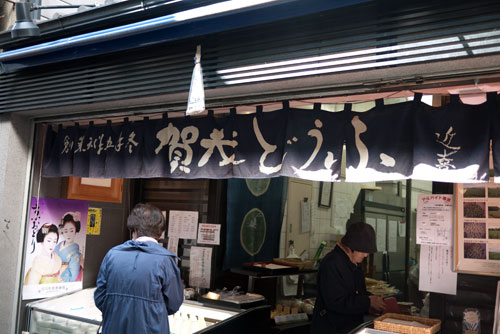
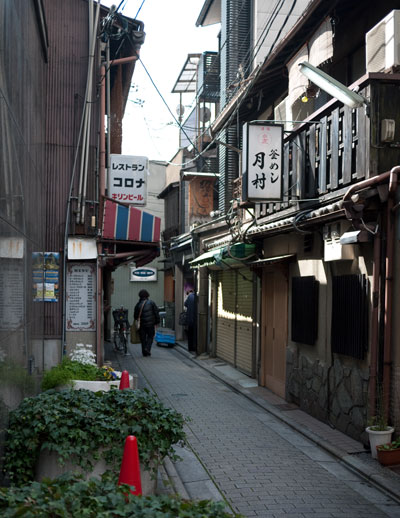
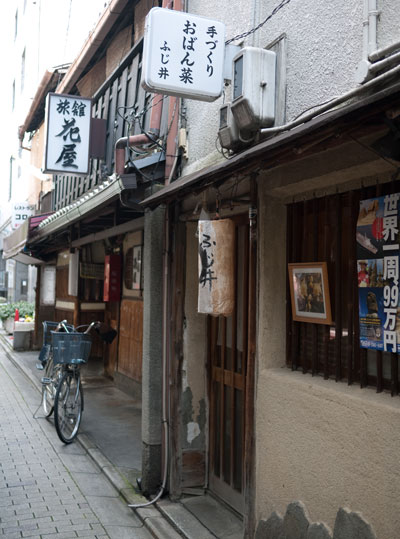
The second storefront is a bit more modern, on a narrow road that runs across the Takase river, pictured above.
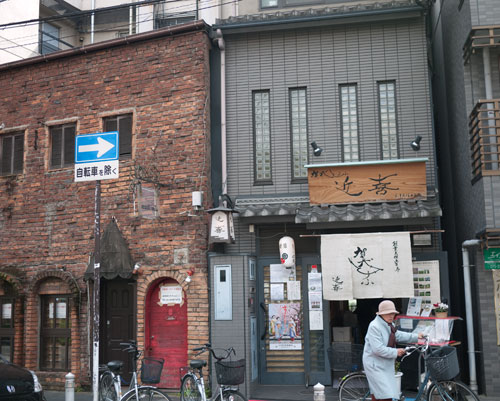
My mother has Kinki's soy milk delivered weekly to her home in Yokohama. (I've told you already that my mother is way more particular about her food than I.) I must admit to not being a big fan of soy milk; to me it usually tastes like hay. Kamo Tofu Kinki's soy milk is so rich and creamy and fresh tasting, that it's likely to convert the most die-hard anti-soy milk person. Their soy milk is made from non-GM, domestically produced whole soy beans (marudaizu, 丸大豆). The very short ingredient list is very reassuring - just soy beans and an anti-foaming agent.
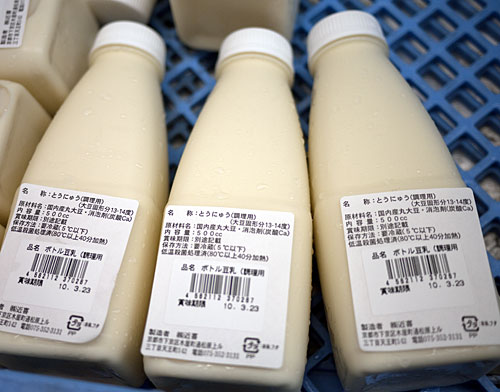
They make three kinds of soy milk: regular white, which is the thickest and creamiest; red, made from naturally red soy beans and tastes quite light; and green (made from soy beans that are green when ripe) which is somewhere in between the two and is my favorite. Here are a bottle each of their red and green soy milks. The bottles are translucent, so the color you see is the actual color of the milk.
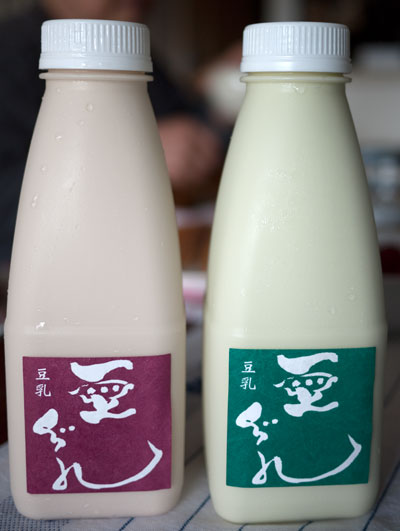
Naturally, the tofu and other products made from this rich, delicious soy milk is bound to be good. And it is. Here's some of their bi-colored tofu, made with soy milk from the aforementioned green soy beans mixed in with white.
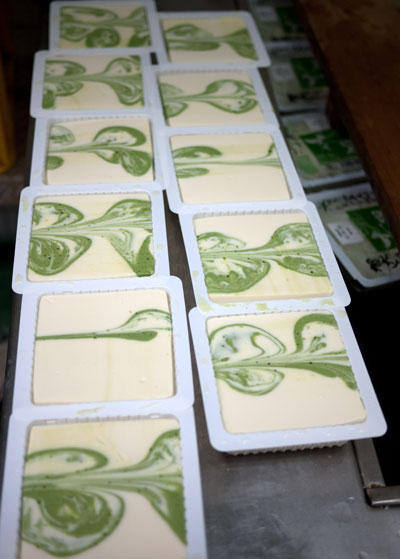
The tofu workshop is really narrow. I felt really in the way there, trying to take photos, but everyone was very nice. It was interesting to see that they make tofu essentially the same way that I do when I make it at home. The only difference is that they use various pressing, forming and packing machines.
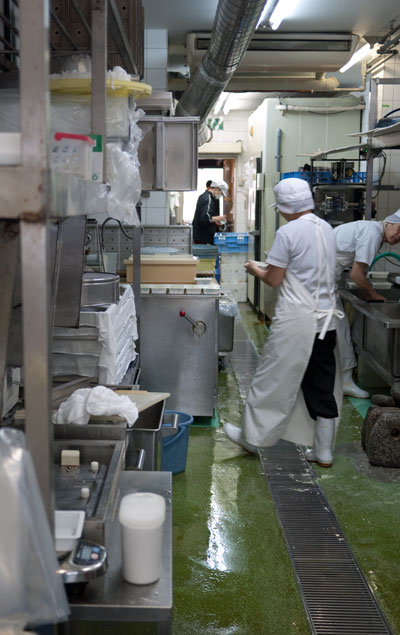
Making tofu is a very steamy business.
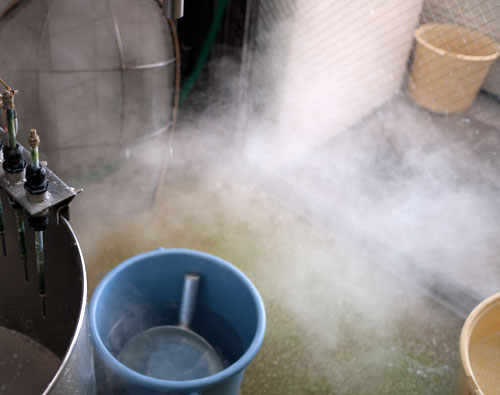
Their agemono - fried tofu products like aburaage, hiryouzu or abura-age (also called namaage) and atsu-age and hiryouzu, are made at the other store, which is actually the headquarters. The ladies of the family are in charge over here.
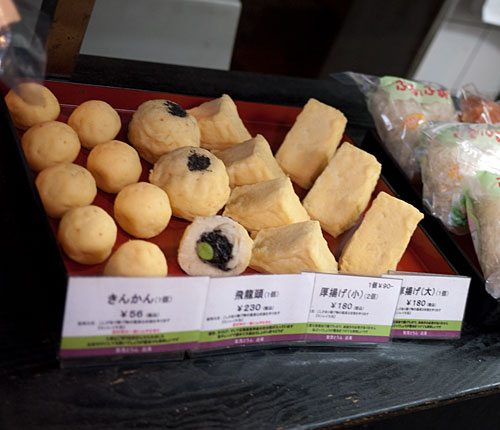
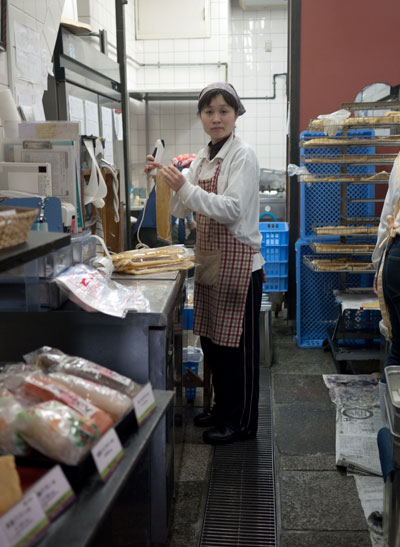
Some of their fresh aburaage (thin fried tofu), called o-age-san (お揚げさん) in Kyoto dialect, cut up for sampling. It's so good you can just eat it as-is, or with a drop of ponzu sauce (a vinegar and soy sauce sauce) as Kinki recommends. You may have seen their large aburaage sheets in this post on Just Bento, where they made a long trip all the way to southern France. I wish I could take Kinki's whole operation back with me in my suitcase.
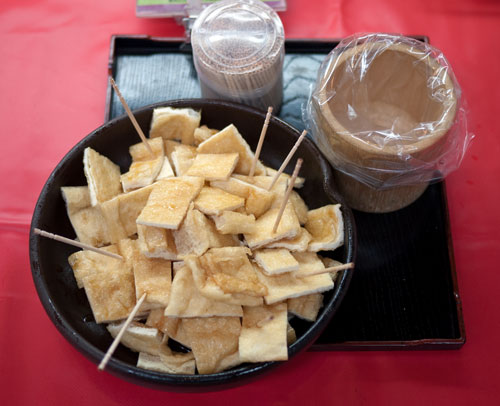
Fresh okara is also available, in red, green and white variations of course.
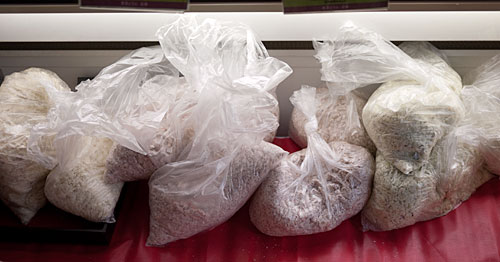
So So An, Kinki's tofu restaurant
As much as I wanted to, it's rather difficult to sample tofu products in a hotel room. So a couple of days after visiting Kinki's stores, we had lunch at Sosoan. Sosoan (爽草庵; also can be written as So So An, Sousouan or Sou Sou An) is a fairly new operation by the Hayashi family. It's a small, unassuming little tofu restaurant, located in a residential neighborhood just a block away from Tetsugaku no Michi (哲学の道) or Philosopher's Path, near the Ho-nen-in temple.
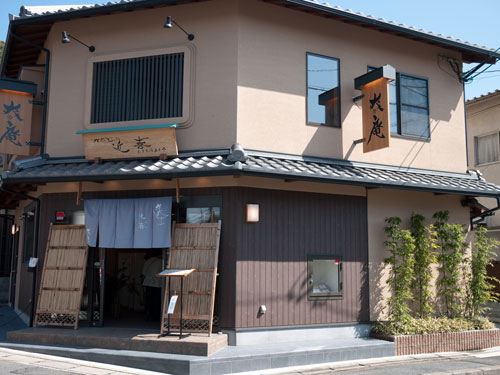
There's a small shop where their tofu products are sold on the ground floor, and the dining rooms are upstairs. There are two dining rooms, one traditionally Japanese with tatami mats (though each table has a hole underneath so you can dangle your feet if you prefer), and a small Western style room with tables and chairs. We chose the Japanese room. It's impeccable, serene and calming, as befits a kaiseki restaurant, but still informal enough to be very comfortable.
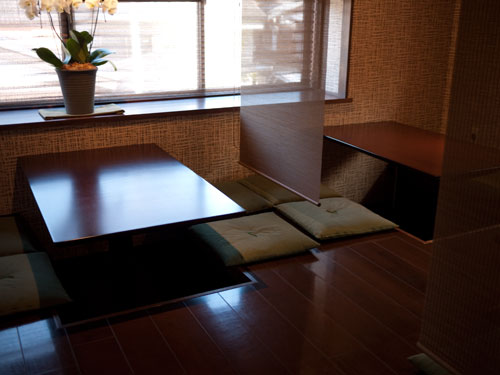
We had called in advance to reserve their full multi-course, tofu kaiseki menu (3800 yen). It started with this dish of tiny hotaru ika or "firefly squid" with ha-gobo (葉ごぼう, burdock plant leaves and stems), a thick green soy-cream sauce and toasted and crushed soba (buckwheat) kernels. (Note: someone emailed me asking why the hotaru ika was not glowing. Well it's cooked, and therefore not alive. A hotaru ika has to actively 'glow'; it's not naturally fluorescent.)
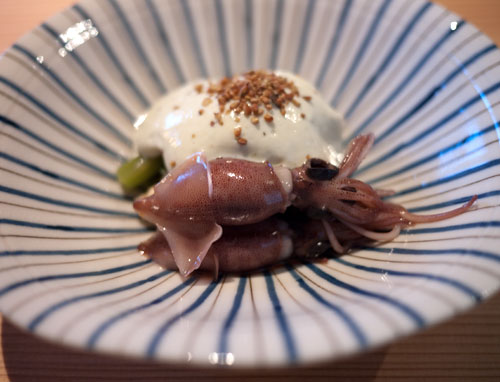
This was followed by perhaps my favorite dish of all, though it's hard to choose really - two kinds of yuba (湯葉), which is made by skimming the top of hot soy milk, with freshly grated wasabi. It was both creamy and slightly chewy, and the wasabi was so fragrant that I didn't feel that usual sinus-piercing hot sensation at all.
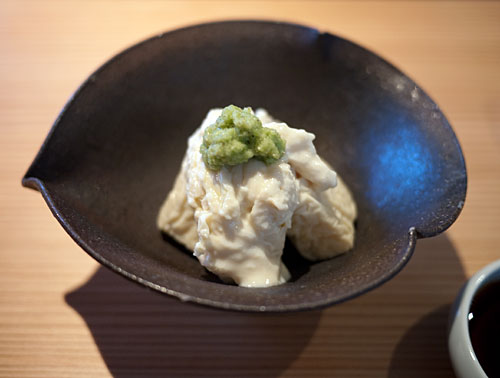
Next was a hot dish, a mini tounyuu nabe (soy milk hot pot) - a soy milk broth flavored with white miso, a square of silken tofu and pieces of aburaage, garnished with a sprig of nanohana (rapeseed plant), a kyo ninjin or Kyoto carrot flower and grated yuzu peel. Kyoto carrots are a deep red-orange. We scooped out the piping hot contents of the nabe into a small bowl to eat it.
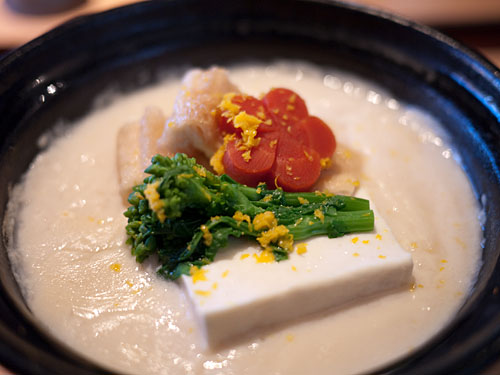
Then came a dish comprised of a piece of poached sawara (a type of mackerel), with a hiryouzu (飛龍頭) - a soft tofu dumpling of sorts, with tiny fresh sakura ebi (cherry shrimp) and pieces of fresh, crunchy takenoko (bamboo shoot).
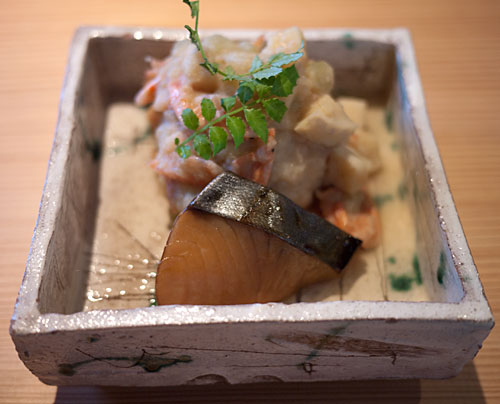
Here's a shot showing the inside of the hiryouzu.
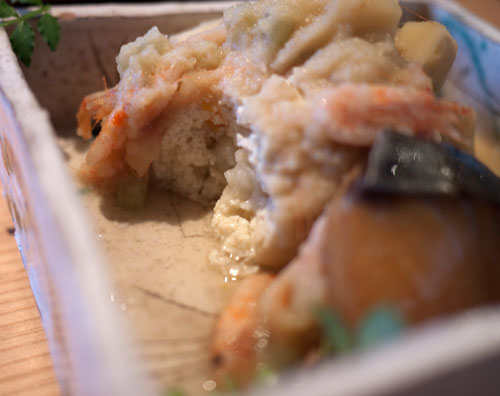
Finally, our last savory course - an ankake don (あんかけ丼) accompanied by miso soup. Ankake means that the sauce has been thickened in some way, usually with potato starch or kuzu flour, and don is a bowl of rice with topping. This ankake don had nori seaweed, thin layers of soft yuba, meaty pieces of aburaage (thin fried tofu), tofu, and sweet, meltingly soft negi (thin leeks) on top of hot rice. I think I would be very happy having this alone for lunch every week.
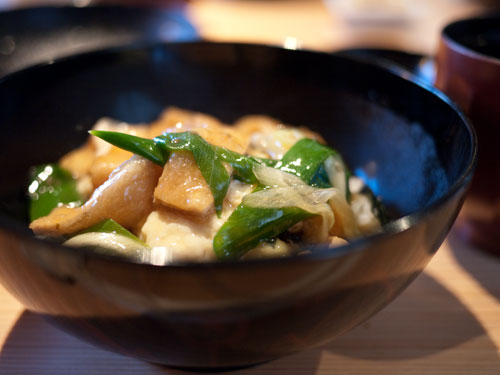
The meal ended with a small dessert, a vanilla tofu parfait topped with yuzu jam.
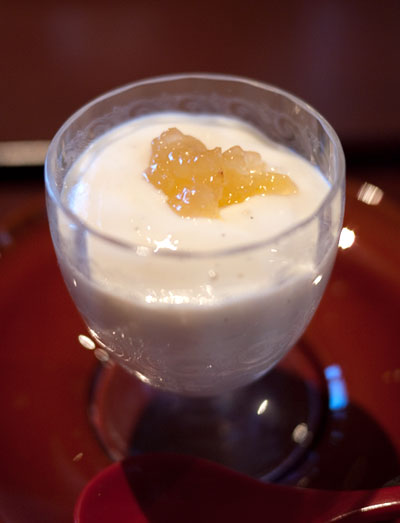
We departed Sosoan comfortably full and very happy, A visit to Honenin and its beautiful garden, and a stroll down Tetsugaku no Michi (Philosopher's Path (or Philosopher's Way or Philospher's Walk, etc.)) to the world famous Ginkakuji Temple, is a perfect way to spend the rest of the afternoon. (More on this area in a later Postcard...)
Practical details
All the locations mentoned are marked on my Kyoto Google map.
Kamo Tofu Kinki web site, in Japanese only. The two tiny stores where you can buy soy milk, tofu and other products are both within a few minutes' walk and a world away from the busy intersection of Shijo Dori and Kawara-cho, near the peaceful little Takase river. The nearest train station is Kawara-cho on the Hankyuu line, and the nearest bus stop is Shijo Kawara-cho. (Note: I noticed that Bon Appetit has a tofu article in their February issue that mentions Kinki. The photo there makes the workshop look more rustic than it actually is - it's really quite a modern, impeccably clean operation. It is very tiny though...it's a wonder they manage to make enough tofu to not only supply the three stores and the restaurant, but the department stores too!) Both stores are open every day from 9:00 - 18:00 (9AM to 6PM), except for the New Year's holiday period.
So So An (or Sosoan), as I've mentioned above is located in a peaceful residential neighborhood a block away from Tetsugaku no Michi (Philosopher's Path), and near to Honenin temple. The easiest way to get there is probably by taxi, but if you can manage to navigate the Kyoto City bus system, the closest stop is Minamida-cho on line 32. Jodoji on line 203 is also quite close. Ginkakuji-mae (several lines) is about a 5 minute walk away.
Tel:075-352-3131; Fax:075-352-3121 (I'm not sure how much English is spoken by all the employees there, so you might want to have a Japanese friend or your hotel concierge call for you.) Hours: 11:30 - 17:00 (last order 14:30) for lunch, and 17:00 - 21:00 for dinner. Closed Wednesdays and the first and third Thursday of each month.
Reservations are required for dinner, and recommended for lunch. The 3800 yen full kaiseki course has to be pre-ordered when making the reservation. Here is their current menu in Japanese, with prices. Please note that the food served at the restaurant is very seasonal (as it is at all good Kyoto restaurants) so what you get is very likely to be different from what I had for lunch! Also, as you can see from the photos, the fact that it's a tofu restaurant does not mean it's vegetarian, just in case you are inclined to think that way.
Some tofu terminology
I've already talked about most of these tofu foods previously on this site, but here's a list of short descriptions for you. Also see Looking a tofu for longer descriptions, and pictures of the more prosaic, supermarket versions of these products.
- tounyuu (豆乳) - soy milk. (Japanese people didn't actually drink a lot of soy milk until fairly recently. I don't remember seeing it around at all growing up.) How to make soy milk at home.
- tofu (豆腐)- In Japan, tofu is not some vegan-health-food to be regarded with suspicion by omnivores. It's a basic staple, enjoyed by all. How to make tofu at home.
- okara (おから) - The leftover fibrous parts of the soy bean after the soy milk has been extracted. What to do with okara.
- aburaage or abura-age (油揚げ)- Thinly sliced tofu that is deep fried using a special process that causes an air pocket to form inside. This air pocket is often stuffed with rice (such as for inarizushi), vegetables and other fillings.
- atsuage or namaage (厚揚げ or 生揚げ)- Tofu blocks that have been slowly deep fried until golden brown on the outside, and solid tofu on the inside.
- yuba (湯葉)Thin sheets of coagulated soy milk, made by skimming the surface of hot soy milk. It is available in Japan as 'raw' or fresh/uncooked, soft yuba (nama yuba) or dried into thin, brittle sheets that are reconstituted before using. You can try making your own fresh yuba by heating up unsweetened soy milk, and skimming off the skin that forms on the surface with a chopstick.
- hiryouzu or ganmodoki (飛龍頭 or がんもどき) - fried tofu dumplings. How to make your own at home.
Footnote: The reality of the tofu business
Reading this article so far, you might get the impression that this little family business is thriving just doing things the way they have been for 180 years. In reality though, the unassuming head of the company (and the family patriarch) Mr. Hayashi, spends his time touring the country, going from department store food fair to department store food fair, hawking their tofu products, leaving his wife, son and his daughter-in-law in charge of things back home in Kyoto. Just looking at his upcoming schedule (Japanese) is exhausting. They also have an online mailorder store. I guess for such a business to survive, it's all necessary, and Kinki is commendably adapting to the times. Here's Mr. Hayashi on a recent trip to Yokohama.
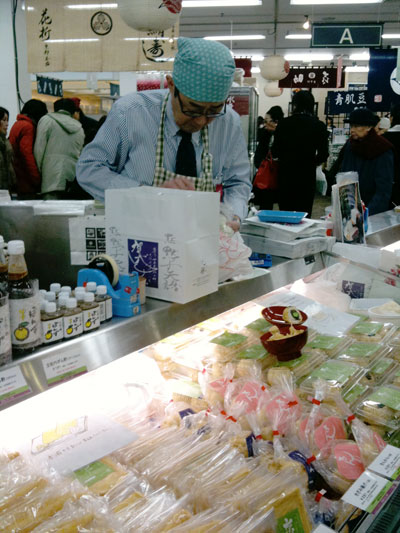
It's hard to believe that anyone who tastes the quality of their products would not become converted, but there's no denying that you pay for quality. A typical supermarket tofu block costs around 100 yen in Japan; Kinki's basic white tofu costs 350 yen. But it's so worth it.
Other Postcards from Kyoto so far
- Sweet Destinations
- Nishiki Market and Masugata Arcade
- Misuyabari and Hakotou, for lovers of sewing and handcrafts
If you enjoyed this article, please consider becoming my patron via Patreon. ^_^


 Welcome to Just Hungry, where we serve authentic Japanese recipes and more! I'm
Welcome to Just Hungry, where we serve authentic Japanese recipes and more! I'm 













Comments
katnhwi
2 April, 2010 - 07:26
Permalink
Re: Postcards from Kyoto - Tofu from bean to plate: Kamo ...
thanks for sharing this, kyoto has so many delicious places, I am adding this to my "to try" list.
nina
2 April, 2010 - 13:08
Permalink
Re: Postcards from Kyoto - Tofu from bean to plate: Kamo ...
Thank you, thank you, thank you Maki for your hard work in keeping us informed.I love all your reviews, and they make me dream of visiting Japan one day. I must say your pictures are beautiful and that they just make me hungry from looking at them. Good luck and best wishes. From Valencia in Spain.
Folly
2 April, 2010 - 17:51
Permalink
Ahh, tofu. . .
Many of us will never know the pleasures of small batch, artisanal tofu. The variety that you showed us in your article is seductive. I've had the pleasure of eating at a Kyoto tofu restaurant, Umenohana, and it was one of the most exquisite meals that I have ever had in Japan. They have a branch in Beverly Hills; but while the decor is beautiful, the food is a mere shadow of that in Kyoto.
For those in the San Francisco Bay Area, get yourself to San Jose Tofu. It is a tiny, family-run operation that barely has enough room for two customers to stand at the counter. They only have one kind of tofu, but it is fresh and delicious, with a texture different from the ones we get at the Megamart. Bring your own containers and they will reach into a large vat and lift out a tender white cube for you. (They will also put it into a plastic bag for you, but then the tofu loses its shape.) Berkeley Bowl and Tokyo Fish in Berkeley get a supply once a week - however, you'd better be there on delivery day as lots of us are lined up for it that day.
San Jose Tofu Company
175 Jackson Street
San Jose, CA 95112
Telephone: (408) 292-7026
Greg Wittel
4 April, 2010 - 06:22
Permalink
Re: Ahh, tofu. . .
[quote=Folly]For those in the San Francisco Bay Area, get yourself to San Jose Tofu.[/quote]
Just another recommendation for this company. I never knew I had it so good until I moved away from the bay area =(. You can also buy their tofu at:
- Imahara Produce (Cupertino near Wolfe/Stevens Creek)
- Nijiya Market (Mountain View near Grant and El Camino)
I usually bought it from Imahara's (cheaper) from their back counter/window where they'll get it out for you.
Greg Wittel
4 April, 2010 - 06:23
Permalink
Re: Ahh, tofu. . .
[quote=Folly]For those in the San Francisco Bay Area, get yourself to San Jose Tofu.[/quote]
Just another recommendation for this company. I never knew I had it so good until I moved away from the bay area =(. You can also buy their tofu at:
- Imahara Produce (Cupertino near Wolfe/Stevens Creek)
- Nijiya Market (Mountain View near Grant and El Camino)
I usually bought it from Imahara's (cheaper) from their back counter/window where they'll get it out for you.
Jason Miller
2 April, 2010 - 18:36
Permalink
Re: Postcards from Kyoto - Tofu from bean to plate: Kamo ...
That marbleized green and red tofu looks amazing. I had no idea the color difference could be so striking. So many applications!
Madura
2 April, 2010 - 20:13
Permalink
Re: Postcards from Kyoto - Tofu from bean to plate: Kamo ...
i love your postcards!
dirty duck
4 April, 2010 - 01:23
Permalink
Re: Postcards from Kyoto - Tofu from bean to plate: Kamo ...
this is so detailed, i loved reading about all that go into tofu and especially how one particular restaurant does their "thang" your explanations are wonderful
Esther
4 April, 2010 - 21:53
Permalink
Re: Postcards from Kyoto - Tofu from bean to plate: Kamo ...
Hello, I'm a new reader to your blog and I really enjoy reading your posts.
I love tofu, and its a pity I didn't really try tofu when I was in Kyoto 3 years ago. (I did however have excellent tofu where I worked on a farm for a bit - we had it on its on w/o soy sauce and it still tasted amazing)
I agree with you that Japan has the best fresh tofu - I grew up eating tofu (in Singapore) but the Japanese tofu was so much more flavourful (in a subtle way?) than anything I'd had back home.
And okara is possibly my favourite soy byproduct. My favourite is when it's cooked with some hijiki, carrots, and spring onions in a bit of soy sauce and mirin.
In my next visit to Japan I must get some of that tounyuu too... looks heavenly.
BarbJ
5 April, 2010 - 04:57
Permalink
Re: Postcards from Kyoto - Tofu from bean to plate: Kamo ...
Dear Maki-san, I've really enjoyed all your reports of your visit back to Japan, thank you!
As a lover of tofu, I was really envious of your lunch. If it tasted as good as it looked you must have been in heaven!
@Folly, thanks for the tip on San Jose Tofu! I'm only about 20 minutes from there, and as I have some time tomorrow morning, I'll be taking a trip down there to get some. Can't wait!!
Caroline in San...
6 April, 2010 - 05:26
Permalink
Re: Postcards from Kyoto - Tofu from bean to plate: Kamo ...
What a wonderful post! Your writing and photos are worthy of Saveur or Gourmet (when it was around) magazines. I've been a long time lurker, but had to write to thank you for such an enjoyable article. Re: San Jose Tofu, I've tried their tofu and didn't find it to be that extraordinary. Perhaps I need to give it another try...
Gemma
6 April, 2010 - 18:43
Permalink
Re: Postcards from Kyoto - Tofu from bean to plate: Kamo ...
I love seeing the pictures of the real way people live and shop in other countries. We hear about it all the time but yet we don't really understand until we see it. I bet the tofu is great there.
Casino Online Gratis: If you want to gamble but cannot travel then you will love this casino online that is available for you 24 hours a day with all the gaming you could ever imagine.
STK
7 April, 2010 - 07:07
Permalink
Re: Postcards from Kyoto - Tofu from bean to plate: Kamo ...
Thanks for the great Kyoto report! I was there for my very first visit last July and every minute of the trip (even when I lost my JR Rail Pass) was beyond memorable. We stumbled upon a vegetarian restaurant near Tenryuji and it was called Anju. It was the best vegetarian meal I have ever had. A small square of artisanal tofu with ponzu, fresh yuba on rice, even the konnaku mochi and warabi mochi were soooo tasty.
http://www.flickr.com/photos/94692651@N00/3806577596/in/set-72157621824752241/
I can't wait for more of your reports from Kyoto. We had a lovely time and look forward to visiting Japan and seeing the rest of the beautiful country soon.
Kaiji Sushi
8 April, 2010 - 23:46
Permalink
Re: Postcards from Kyoto - Tofu from bean to plate: Kamo ...
We love tofu! and this makes us want to go to Kyoto right away!
randy
10 April, 2010 - 12:03
Permalink
Re: Postcards from Kyoto - Tofu from bean to plate: Kamo ...
So So An restaurant was closed thursday the 8th, second thursday of the month. and we were really looking forward.
Aleria
11 April, 2010 - 07:17
Permalink
Re: Postcards from Kyoto - Tofu from bean to plate: Kamo ...
That was really interesting, especially the different colours of soy products. However, I don't know how you could eat that little squid, he's so cute!
Amatō
11 April, 2010 - 12:26
Permalink
Re: Postcards from Kyoto - Tofu from bean to plate: Kamo ...
What a great post, I would love to try some of the products, and the menu you had is to die for...(beautiful tableware)
I had some tasty Japanese tofu, and was amazed about the difference between German (even organic) tofu and Japanese "real" tofu.
I wanted to try to make tofu, with nigari.
Does anybody know how to make silken tofu at home?
Should I use calcium sulfate for the silky texture?
How about black soy beans (kuro mame) for making tofu?
Brett Sutcliffe
11 April, 2010 - 12:38
Permalink
Re: Postcards from Kyoto - Tofu from bean to plate: Kamo ...
Hey amazing Tofu collection. I tried a lot of kinds of Tofu. When I was kid always hate them. Now just start enjoying them with soup, cold, hot...in anyway.
Gemma
14 April, 2010 - 12:16
Permalink
Re: Postcards from Kyoto - Tofu from bean to plate: Kamo ...
Thank you for yet another amazing postcard. I love how you show the real photos from the region. We always hear about life there but your photos show the reality. Did anyone else notice how clean the kitchens look?
Virtual gambling is rewarding at this casino and the excitement is second to none because the slots, blackjack and other games are very realistic. - casino en ligneShannon
30 April, 2010 - 00:20
Permalink
Hello! I just loved this
Hello!
I just loved this post. I live in central Tokyo and I am currently on a mad hunt for the Kamo brand of soymilk (of course I would be delighted to spot the tofu as well, but soymilk is a priority for me). I have never had green or red soymilk, or even seen a soymilk that looks so natural. I need to find this. Do you know of a shop selling Kamo products or a similar brand?
Thank you!
maki
30 April, 2010 - 00:48
Permalink
Re: Hello! I just loved this
Hi Shannon, according to the Kamo Kinki Tofu site list of stores that sell their products, their products are carried by both the Nihonbashi (flagship store) and Shinjuku Takashimaya stores, as well as the flagship Tokyuu dept store. If they don't have a certain product (e.g. the Yokohama Takashimaya carries their tofu but not their soy milk) you can have it special ordered. Look for their stuff at the Aji Hyakusen (味百選)counter of the food halls in Takashimaya, where they have a variety of products from small producers.
bellagatta
8 May, 2010 - 17:38
Permalink
Re: Postcards from Kyoto - Tofu from bean to plate: Kamo ...
This is the Kyoto I know. Thanks for the wonderful site and my recollection of Happy memories and excellent cuisine.
I know how to make soymilk but it's easy to buy in the Chinese market.
I love anything with tofu. I remember all the little shops with their specialties!
That's what I love about Kyoto. Food is taken to another level with pride and art, real artisans! Appealing to the eye with excellent taste. Very high standrads, on food stuff. Oh Yum!
Camilla @ FoodR...
29 May, 2010 - 19:22
Permalink
Re: Postcards from Kyoto - Tofu from bean to plate: Kamo ...
Wow, what an interesting post! We're planning to visit Japan for a couple weeks this summer, and I HAVE to try some of this tofu!
anon.
4 June, 2010 - 20:51
Permalink
Thick Soy Milk
I remember when i was in japan i bought a bottle of freshly made soy milk from a small shop like that. I grew up on chinese soy milk which is quite watery and sweet so the viscous and creamy unsweetened delight from this bottle was amazing.
Then i told my friends and we all came back and the locals watched us with amusement as we glugged down the soy milk (since there was some westerners among us). Never encountered soy milk like that outside japan.
NKD
31 December, 2010 - 12:31
Permalink
Re: Postcards from Kyoto - Tofu from bean to plate: Kamo ...
Bonjour,
I really love your blog and have been reading it for the past year or so. Thank you for putting so much care and effort into your posts!
I want to ask you about the price for the tofu meal at Sosoan. Is it 3800 yen per order/set meal? Is it okay
for two persons to share an order?
Merci beaucoup d'avance!
maki
31 December, 2010 - 12:38
Permalink
Re: Postcards from Kyoto - Tofu from bean to plate: Kamo ...
3800 yen is for a multi-course degustation per person. They might not be okay with 2 people sharing an order (it's not normally done in Japan). But they do have less expensive options too - actually the 3800 course is the most expensive offering they have. (See their menu (carte) - in Japanese but you can see the prices. The 2800 yen offering is a simpler version of the 2800 yen offering, and the 1500 yen item is a very filling donburi (rice bowl with lots of toppings).
NKD
3 January, 2011 - 10:42
Permalink
Re: Postcards from Kyoto - Tofu from bean to plate: Kamo ...
Thank you for the clarification and menu. If we make it to Sosoan I will let you know. Happy New Year and all the best wishes for Just Hungry and Just Bento!
jhalo7
25 March, 2012 - 18:31
Permalink
Re: Postcards from Kyoto - Tofu from bean to plate: Kamo ...
Hi Maki, I'm planning for my end of April trip to Kyoto now and your Kyoto postcard series has been excellent for me! I'm going to most of the shops you wrote about including Sousouan.
I have a question about Sousouan. I've gone to their website and saw the menu. Is the 3,300 yen set their current full kaiseki course set? When I clicked on it, there seems to be several different sets. So when we reserve for lunch, do we pick from the sets listed there?
Also, roughly how long did it take for your to finish your meal?
Lastly, do you know how long the freshly made aburaage from Kinki's will last? I'm thinking of buying some back home. Can we store in the freezer to lengthen its shelf life?
I can't wait to visit Kyoto!
maki
25 March, 2012 - 19:18
Permalink
Re: Postcards from Kyoto - Tofu from bean to plate: Kamo ...
The 3300 yen is for their current kaiseki menu. It is basically 'omakase' - that is, the chef has chosen for you what he thinks is the best meal for the season. The link on the top right there just leads to a page where you can see past kaiseki menus. It does look like they have drastically simplified their menu so your choice is either the kaiseki or the 1500 yen yuba donburi (yuba and vegetables on rice). You do need to let them know when you make a reservation that you want the kaiseki. (It's really a small restaurant)
The kaiseki takes an hour to 90 minutes, depending on your pace. It's worth enjoying leisurely.
If you can keep the aburaage refrigerated, it will keep for a week or so with no problem. You can freeze it too.
Kavey
27 October, 2012 - 11:56
Permalink
Sosoan
Having just got home from my first visit to Japan, I had hoped to be able to visit this restaurant, having come across your blog post during my trip research. Sadly, it was not to be, as a bout of illness meant we never made it to the Philosopher's Path or Sosoan, as planned. Am keen to return to Japan, so perhaps next time.
Just wanted to thank you for an informative and inspiring blog.
chloe
12 April, 2013 - 03:19
Permalink
Re: Kyoto - Tofu from bean to plate: Kamo ...
Sadly, I could not find Kamo's second store as per the map location. And did not have time to search for the main store
Esther
15 June, 2014 - 17:20
Permalink
Re: Postcards from Kyoto - Tofu from bean to plate: Kamo ...
Was planning my Kyoto trip and wanted to add Sosoan into my itinerary but observed from Kinki's website that the restaurant has closed? =(